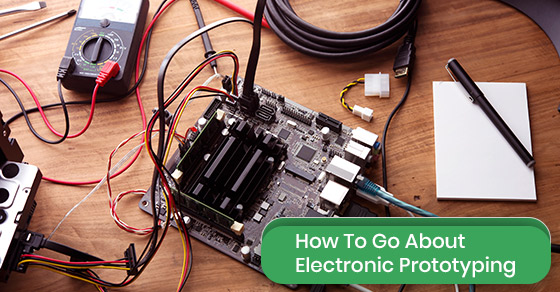How To Go About Electronic Prototyping
The prototyping process involves growing pains. Each time a new version is created, the designer will learn something new. We would suggest that you begin with the lowest cost and most basic way to prototype your item.
Then, as your prototype continues to evolve with each successive iteration, you will eventually reach the pinnacle of quality. The end goal is to eventually create a production-quality prototype.
During the preliminary stages of prototyping, it is best to separate the item into multiple prototype versions. Each type should have a unique goal. For example, some can be works-like prototypes, while others can be looks-like prototypes.
Here, we will delve into the exciting world of electronic prototyping and discuss the best strategy to tackle your project.
Looks vs. Works
A works-like prototype emphasizes the pragmatics of the item. Here, the goal is to resolve any technical problems that may have formed. Functionality, then, is inextricably linked to the electronic device, whereas appearance is linked to the enclosure.
As for look-like prototypes, the focus is on the form, feel, and aesthetics of the product in question. Here, injection moulding will be at the forefront, as will 3D printing, clay, CNC machining, and foam.
Getting back to works-like prototyping, you may need to start with popular dev kits like the Raspberry Pi or Arduino. Breadboarding often goes hand in hand with works-like prototyping as well.
When you fabricate a proof of concept prototype, the goal should be to showcase the product concept's rudimentary functionality.
However, the end goal will be to merge the two types, meaning you should eventually create a looks-like/works-like prototype. To do so, you will need to make the transition towards a custom printed circuit board development. This is the only way to amalgamate form and function together.
Which should I begin with?
Determining which to begin with (looks versus works) may be difficult for some designers. However, one easy way to decide is to assess what aspect has the greatest amount of risk. Which area also has the most questions tied to it? Even the specifics of your product will affect which to begin with.
For example, if your top priority is the feel and look of the item, then you should start with a looks-like prototype. Conversely, if you are uncertain about many technical aspects of the item, then a works-like prototype is the way to go.
Of course, some products may prioritize each other equally. If the following applies to your product, then we would suggest that you build both. You will then need to work on both simultaneously, while also keeping the two apart.
Another possible scenario is a product that doesn’t have any significant unknowns related to pragmatics or aesthetics. In such a case, a looks-like/works-like single prototype may be best.
The final thing to remember is that you will eventually need to create a looks-like/works-like prototype even if you decide to begin with just one of the two types. Your end goal is to build a prototype that is of production quality, meaning it will be congruent with your final consumer product.
How to Begin Prototyping
Before beginning prototyping, you need to focus on the questions that you must answer. With each successive prototype, you should have clear-cut questions that the current prototype must answer.
If you do not have any far-reaching questions about the functionality of your product, then you can begin designing your custom printed circuit board.
In fact, most companies that develop products will go straight to working on custom printed circuit boards. However, it must be noted that taking the fast route is not the cheapest route, so we would not recommend it if you have a small budget.
How to Develop Prototypes with Raspberry Pi and Arduino
Virtually all of the electronic products on the market will need a microprocessor or microcontroller to operate. The Raspberry Pi series works with microprocessors, while the Arduino series works with microcontrollers. Both types serve as computer chips that are used to run various programs.
Microcontrollers have the benefits of being less expensive and less complex. However, they also tend to be less powerful. If your product needs accelerated computer processing, we would not recommend that you go with a microcontroller.
However, most product ideas do not require very high-speed processing so that microcontrollers will fit the bill nicely. Microcontrollers also simplify matters, as they are System on Chip products.
They include memory, such as RAM and ROM, as well as a CPU. They also tend to have some other peripherals that are also embedded on the same chip. The required printed circuit board design is simplified because of all of the included components.
If you need something with some added peripherals, then you may be able to obtain a microcontroller that includes state-of-the-art peripherals, such as a Bluetooth radio with low energy readings.
Microprocessors also require an operating system, such as Linux, Android, or Windows. Microcontrollers, conversely, do not require an operating system in order to function.
Firmware development for a microcontroller is much easier than trying to program for a microprocessor with an operating system.
In summary, microprocessors are often used in powerful devices, such as personal computers, while microcontrollers are often used in music players, washing machines, and other “weaker” or less complex appliances.
The Circuits Central Difference
If you would like to learn more about electronic prototyping or require electronic prototyping services from a full-service prototyping company, then we can help. Circuits Central provides pre-manufacturing, manufacturing, and post-manufacturing services.
We also offer a la carte solutions, testing, conformal coating, and electronic circuit design. We work with a diverse clientele, including the communications, commercial, aerospace and defence, and medical sectors.
To learn more, please give us a call at 888-821-7746. We will be happy to provide you with a free, no-obligation consultation and quote regarding our electronic prototyping services.

